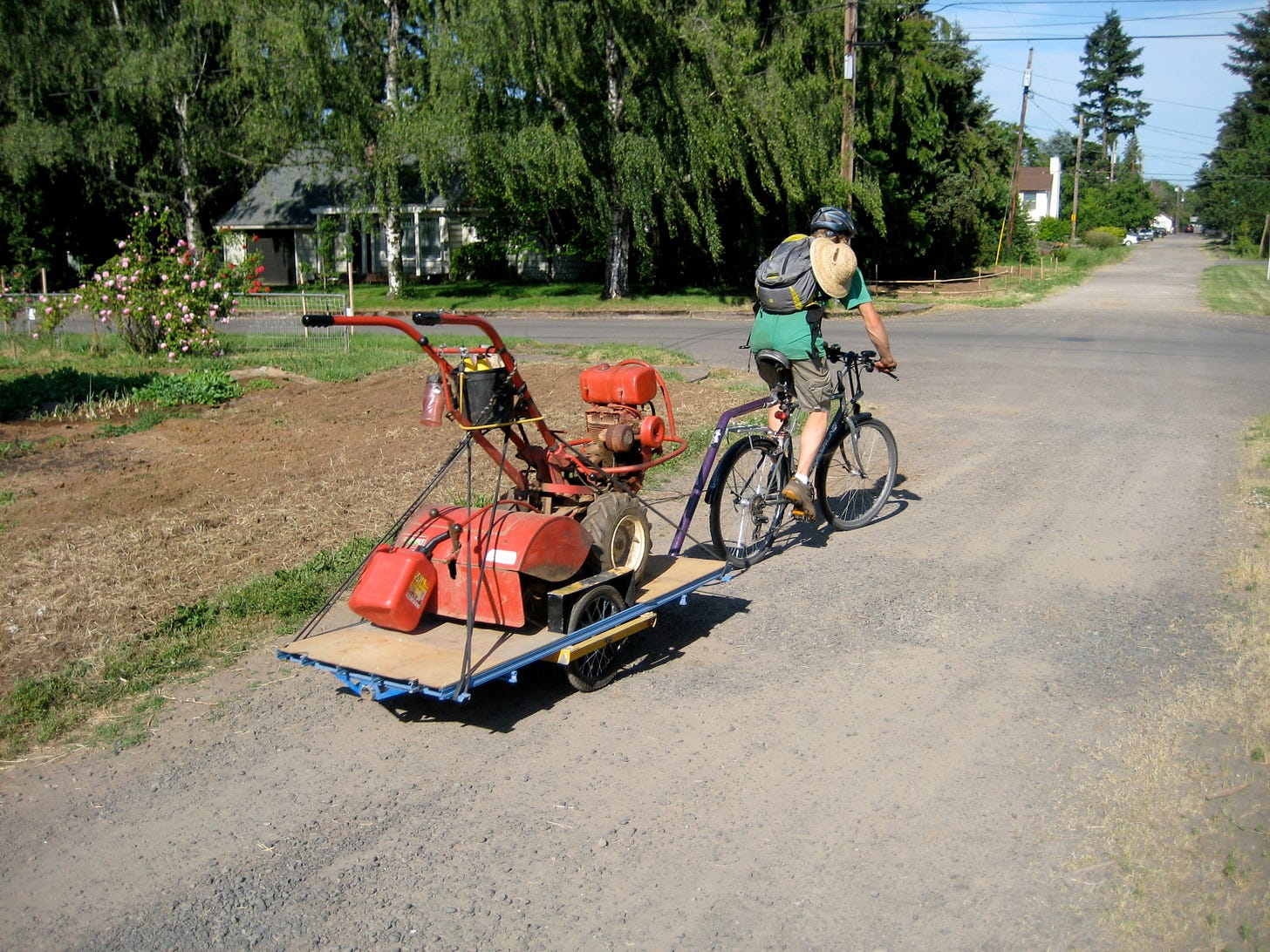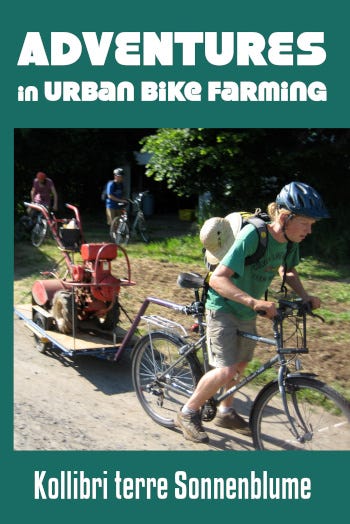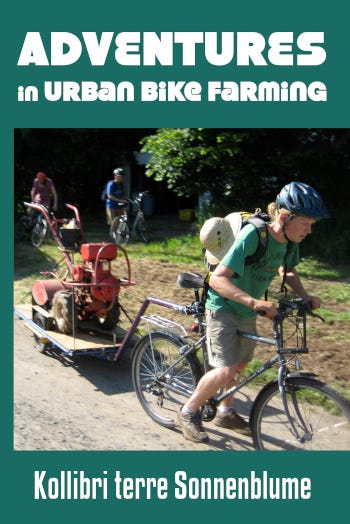
This is a chapter from my book, “Adventures in Urban Bike Farming,” which relates the history of my bicycle-based CSA farm in Portland, Oregon, which I ran from 2007-2010. There are two autographed copies remaining for sale (click here) or you can purchase a digital download (here), which has a color photo section. I’m posting this today because it relates to events that happened 18 years ago this month. This chapter is about big hopes & plans, drama & disappointment, and resilience & recovery. I hope you find it entertaining and perhaps inspiring.
“Life is what happens to you when you're busy making other plans.” (John Lennon)
As the 2007 farm year opened, I had a clear plan.
I had struck a deal with another farmer, Lancia, whose mother owned land in the country near the town of Westfields, outside Portland. Lancia and I had met at the co-op's farmers' market in Northeast where she was also peddling produce. During slow spells (which was most of the time), the two of us talked about farming, where we wanted to go with it, and what inspired us. Lancia was around my age but this was her first season farming. Though I had only started in earnest in 2005 myself, I was a life-long “plant person” who had been raised by gardeners so she saw that she could learn a lot from me. For my part, I found her pleasant and interesting to hang out with; she was a lesbian and a breast-cancer survivor with a double-mastectomy, so she was not “normal”; her brush with death had given her a wider perspective.
We visited her mother's land together in 2006 to pick blackberries for market so I got to see her set-up. She had three acres altogether in some bottom-land next to a wooded watercourse. She didn't need all the space to herself, so together we came up with a plan to split the area between our operations, but to collaborate on planting, cultivating and harvesting, and to share costs like fuel and bulk amendments. We would sell our produce altogether in two markets every week, but alternate who was taking everything in. That way, each of us would make money from two markets but only have to attend one. Last but not least, I could park a trailer out on the land so I had a place to live.
We talked all this out with her mother, who, despite being rather imperious, issued her stamp of approval. She was proud to see her daughter investing herself in the land, and understood that I could be a real asset. The only tense moment came when Lancia's father, who, like me, was originally from Nebraska, asked if I was a Cornhusker football fan. You would have thought I was confessing to pedophilia from the look on his face when I said, “no.” I was reminded of why I had left the Midwest. Fortunately he was not the decision-maker so that wasn't a deal-breaker.
By January, the three of us had hammered out the details and written them up so I put out a call offering CSA shares to my activist friends and to Permaculture circles. I sold a ten CSA shares total, at $300 for a half share and $500 for a full share, which were medium-to-low price at the time. I collected most of this up front and bought seeds, tools, soil amendments, books and market supplies.
“Sunroot Gardens” was the name I gave the CSA. The Sunroot (Helianthus tuberosus) is a knobby root vegetable better known as the “Jerusalem Artichoke” and is the perennial cousin of the beloved Sunflower (Helianthus annuus). It has similar flowers, though they are much smaller. Sunroots are wicked hardy and very tenacious: they are totally frost-tolerant, thrive in heavy clay soils, spread like weeds, and are nearly impossible to remove from a spot once they establish themselves (which only takes one season). They are the only cultivated vegetable that is native to North America. I found all these characteristics inspiring and also just liked the word, “Sunroot,” as it brought the concepts of warmth and light with soil: grounded but reaching heavenwards.
In early February, Felicia helped me move a 14-foot residential trailer out to the land, which is to say she drove the truck that hauled it. It was a challenging task and there was some gritting of teeth and a few curses from her lips. (I returned the favor a few years later by driving a moving truck from Portland to Seattle for her, with some curses of my own on that city's narrow, congested streets.) The trailer was a gift from Harry McCormick of Sunbow Farms, in Corvallis, another farmer friend from the co-op market. Harry's career as a farmer dated to the back-to-the-land movement of the 70's. He was one of the pioneers of the organic movement and a founding member of Oregon Tilth. I wanted to absorb some of the mojo of that crowd and considered the trailer to be a talisman of sorts.
At the end of February I started planting. During this period, I spent half of my time in the city and the other half in the country. To get to the farm from the city, I would ride my bike to a Max train stop in downtown Portland, take it to the end of the line in Hillsboro and then bike another nine miles on country roads. Those were fun jaunts, and the challenge of the journey added to the sweetness of my time out there. I would work until sunset and then sit back with my feet up, pour a glass of home-vinted Dandelion wine and smoke a spliff as I gazed out over the fields until the stars came out. It was quiet by day and dark at night, in marked contrast to the city. Even though my time was full of labor, I felt myself starting to unwind out there in some deeper ways.
Whenever I arrived back in Portland, my first stop would be the old Red and Black Cafe on Division Street where I would order a “Multi-tasker,” which is a pint of stout with a shot of espresso in it. The espresso was for bringing me back up to speed with the city, and the stout was to cushion the blow. While in town I would check in with friends and investors, pick up supplies, and plot out the next steps of the project. Everything was humming along well, all “according to plan.”
I lived this lifestyle for just six weeks before it came to an abrupt end. Here is how I told the story to my CSA investors:
Subject: CSA update from Kollibri!
04/24/2007 01:51:48 PM PDTHello CSA subscribers!
Here's an email update for y'all, about what's going on with this year's produce. I wasn't expecting to send out anything this season with such dramatic news. This mail might read a little like a novel, which is good because it's a little long perhaps, so it better be entertaining, right? Future correspondence will be shorter and less dramatic (I sure hope).
First, the basics. Here's what's been planted so far this year. You, the CSA subscribers, are first in line for all of this. What's left-over will be sold/bartered at farmers' markets and distributed to helpers, friends, etc. Amounts are measured in size of patch (i.e., 10 x 10), or by row-feet (10').
Peas: sweet crunchy snap peas, 3 colors of snow peas - 60 x 60
Roots: 7 kinds of beets, 9 kinds of radishes, 4 kinds of turnips - 75 x 60
Nantes carrots: 150'
Kohlrabi: 2-3 kinds - 90'
Chard, Bright Lights: 69'
Arugula: 63'
Chicory: 57'
Lacinato Kale: 54'
More arugula (diff. seed): 54'
Spinach: 48'
Ruby Orach: 44'
Chickweed: 42'
Edible chrysanthemum: 30'
Omega flax: 5 x 5
Dandelion: 100'
Mixed lettuce: 40'
Spring salad mix: 50'
Mustard greens: 80'
Fava beans: 350'
Mustard greens (diff. seeds): 6 x 10
Poppies, 'breadseed': 30'
Shallots: 45'
Garlic: 75'
Oats: 70 x 20
Brown flax: 35 x 40
Lentils: 240'
Garbanzos: 60'
I was excited to get so much in the ground. And it's all coming up great so far 'cept for the carrots; they might need a little more warmth first. I put them out darn early, honestly. These veggies cover an area about a quarter acre in size, maybe a little bigger. It is the largest single spring planting I have ever done, by far. Yippee!!
DA DA DUM... The Dramatic Part:
That's everything that got planted out on the acreage in Westfields. As many of you will recall, I have been talking about this land, and working with the farmer there, since late last summer. By winter we had struck our deal for the season, which was this: a) $75 lease for the land, paid to the owner ($50/acre, what she charges everyone else), and, b) a deal with the other farmer that we would do two farmers markets together, with each of us just doing one and bringing the others' produce along. A great deal—you get to offer your produce at two places, but only have to go to one of them yourself.
Well, the deal didn't last. After arriving at the land, the owner added a condition: Pay utilities. Okay. That added $350 for the season to the expense side of the budget. I had to rework the numbers in a serious way by cutting back in other areas. Then, after being there for six weeks and having planted all of the above (plus a bunch of medicinal herbs), the owner demands that I purchase a $1,000,000 liability insurance policy. The cost of that (according to a quote from Country Insurance, which the other farmers around here use) is $625-$700.
So, suddenly, the cost of being there had risen from $75 to as much as $1125, with a big chunk of that going to the freaking Insurance Industry, which is just a form of Legalized Extortion, in my opinion, and exactly the sort of B.S. we're trying to get away from by organizing new distribution systems like CSAs in the first place!
This wasn't going to do, obviously, so a new deal was struck. I will not be purchasing liability insurance. I may still harvest what I've planted so far. However, I may not plant anything else, and I can only go to the farm by myself. And everything's gotta be outta there by Aug. 1. I also reduced the utility charge, and will be paying only $100 total.
So, what this means is that alternate land will be needed to plant everything else that's been planned for the year. I am looking in the City only, for ease of transport. Fortunately, three offers of small parcels have already come in, and today I landed a larger parcel (100 x 30). All are within 12 blocks of my house. I still need to come up with a bit more—another 3,000-5,000 square feet or so to get everything in the ground, but I am confident that this will appear. And best of all, I have not fallen behind my planting schedule! Nothing so far is being planted 'late'; it's just going into places that I hadn't been planning to plant it.
But, like, "No Worries, dude":
Ultimately, you as CSA subscribers should not suffer any interruptions-in-service from these changes in where I'm growing food. In fact, some produce will now be fresher as it will be traveling a shorter distance. However, this distributed model could produce some as yet unforeseen logistical issues that might come to your attention, though I will certainly be working to avoid such scenarios.
Also, if I need help with something, y'all will be some of the folks I will be alerting. Among other things, I might need some assistance with transportation from the country to the city from time to time, in the form of borrowing a vehicle, depending on how things go down with Lancia. In our original deal Lancia was going to be providing a truck, but that's more of a question now.
OK, ALREADY, WHEN DO I START GETTING FOOD?!
Originally, I told people "the end of April," which is now upon us. I am now saying "sometime in May." I have never planted a lot of these crops so early, and I didn't take into account that they grow so much more slowly in the early spring than in the late spring. So, it's all taking longer than I thought it would. But it's all definitely coming along, and at some point will become a Flood. AND, no matter when the season starts, it will last at least 27 weeks total, as promised. We'll go through the end of November if we need to.
SO... I will send out another email in the next couple weeks as I get a better idea about when the exact start date will be.
Please call or email with any questions, ideas, leads-on-land, wishes-of-congratulations, or otherwise. I now have a cell phone number: 503.xxx.xxxx. Call anytime.
xoxoxoxo,
Your CSA Farmer,
Kollibri terre Sonnenblume
“This distributed model could produce some as yet unforeseen logistical issues”—ha! That turned out to be quite an understatement. “Unforeseen” would be the watchword over the next four years and the “logistical issues” that emerged ultimately made the enterprise unworkable. At that moment, though, I wasn't thinking big picture, or any further ahead than the next planting date. My planned flight had become a forced landing. It was all I could do to simply not panic.
The scramble for real estate was my top concern. The first person I contacted was Susan to see if she had found someone else to tend the old Lemon Balm Garden plot. She had, but upon hearing of my plight, wanted to return it to me. The new caretakers, however, would hear nothing about it. They were a non-profit organization and they considered the deal done. Apparently they even made some kind of legal threat. Susan apologized to me and wished me well.
Fortunately I had an expansive network of friends and acquaintances in town so when I put out the word for garden spaces, I got some. By the end of that same month, I had already collected several.
Subject: This is your first week of produce!
04/30/2007 08:09:55 PM PDT...In other news I will be working with Terwilliger Community Farm in SW Portland to plant much of the summer/fall crops. Altogether, I will be tending to SEVEN different plots in the city to grow everything I had planned. With the addition of the quarter acre I get to use at Terwilliger, I am now set for the season and no longer need to find more land. So, the drama is over regarding the loss of the land in Westfields, and everything's all set to grow wonderful food for all you wonderful people this year.
I am super excited to be offering y'all the first food of the season, and suspect that this is going to be the funnest summer of my life!
That optimism wouldn't last, but it helped me through some challenges in the meantime. The “drama” over the loss of the land might have been over, but the effects would be felt for the rest of the season. April is a late date to start over the farming season in the Pacific Northwest.
At the time, seven gardens seemed like a huge number to tend. Little did I know that a year later the total would exceed thirty. There wasn't much I pegged correctly during this transition, but I was right about one thing: it did turn out to be one of the funnest summers of my life.
This book is available for purchase Two autographed copies remaining for sale (click here) or you can buy a digital download (here), which has over 100 color photos.





What a journey. Am super keen to read your book.
_Adventures in Urban Bike Farming_ is very amusing and informative, top recommendation! Sonoma County has started the 'Buy-Protect-Sell Program' which can be viewed on the sonomaopenspace.org webpage - which would sell small/midsized plots at much lower cost to farmers and ranchers - the wine business here is starting to crash.......